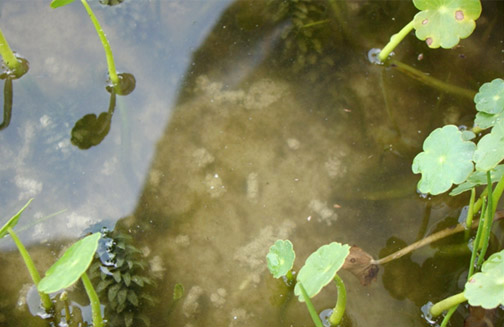Selective Application of Aquatic Herbicides
The goal of plant managers is almost always to control invasive plants without harming the native plants that grow in the same area. To accomplish this, they must apply registered aquatic herbicides selectively. Professional managers perform selective applications through use of specially formulated herbicides, seasonal applications, selective methods, and varying concentrations.
Selective Herbicides
Several herbicides are specially formulated to target specific plant types, and not others. For example, herbicides from the phenoxy family, such as 2,4-D, are commonly used to control broadleaf plants such as the non-native water hyacinth (Eichhornia crassipes). Because of their chemistry, these phenoxy-based herbicides do not harm beneficial native grasses like Paspalum and Panicum spp. Therefore, 2,4-D can be used to selectively remove water hyacinth and enhance native grass growth. Studies have indicated (Sprecher, et al, 1998) that 2,4-D and triclopyr can be used to selectively kill Eurasian water-milfoil (Myriophyllum spicatum) while leaving the native sago pondweed (Potamogeton penctinatus) unharmed. Repeated 2,4-D use, however, is toxic to bulrush (Scirpus spp.), a highly beneficial native plant whose stems provide fish habitat and whose seeds are utilized as food by waterfowl. When water hyacinth is mixed with bulrush, the more costly and slightly less effective herbicide, diquat, is used to selectively control the invasive exotic. Diquat will cause spots on bulrush stems, but will not kill this valuable native plant.
The herbicide’s activity in the root zone is also important. Because 2,4-D, triclopyr, and glyphosate have little root activity and break down quickly, there is low potential for non-target damage due to root absorption. In contrast, caution must be used with root-active herbicides (e.g., imazapyr). In shallow, porous soils, extra care must be taken with all herbicides to avoid root absorption by non-target plants.
Herbicide formulations and adjuvants (substances which enhance herbicide performance or application) are also used to achieve selectivity in a variety of environmental conditions. In still water, herbicide and adjuvant formulations such as granules, pellets, inverted emulsions or polymers can increase the localized impacts of spot treatments. These formulations effectively “package” the chemicals in a manner that will keep them at the application site longer, making them more effective against the target plants.
Seasonal Applications
Applying herbicides at the appropriate stage in a plant's life cycle (seasonal timing) can increase plant selectivity. Proper timing also can reduce rates of herbicide use and the need for multiple treatments in a season. Timing may lessen impacts on non-target vegetation because the difference in life-cycle between target and non-target plants can result in different effects by the herbicide. For example, large scale hydrilla (Hydrilla verticillata) control is mostly conducted in winter and early spring when hydrilla is actively growing but most native plants are dormant. Winter treatments of hydrilla also require a reduced quantity of herbicide since the plant will readily uptake the herbicide during this season.
Seasonal variations in temperature can help promote selectivity. There is more dissolved oxygen in the water during cooler months. Therefore, applying a slow-acting herbicide like fluridone, penoxsulam, or topramezone allows thousands of acres of hydrilla to be controlled at one time without a significant dissolved oxygen reduction and potential fish kill. Alternately, a fast-acting herbicide such as 2,4-D, diquat or endothall may be the best choice for small applications to target plants where spread from the application site is a consideration.
Climate is a very important consideration when applying herbicides. Drift of herbicide spray to non-target plants must be avoided. Particulate drift can be minimized by avoiding windy conditions when spraying and by using low pressures and larger nozzle sizes. Volatile compounds such as ester formulations may cause non-target damage due to vapor drift when applied on very hot days. Evidence of drift includes wilting or curling leaves on non-target vegetation.
Selective Methods
Selectivity is also accomplished with equipment. Spot treatments using a small backpack sprayer or hand-gun can target plants more precisely than trailing hoses or aerial applications.
Manual spot treatment is most effective for small-scale projects such as removing patches of torpedo grass (Panicum repens), water hyacinth, or water lettuce (Pistia stratiotes) invading native shoreline vegetation. The use of appropriate sprayer nozzles, pressure, and adjuvants such as polymers that reduce spray drift, improves the selectivity of such applications.
Varying Concentrations
Herbicide concentration and duration of treatment are also useful ways to selectively control target plants. Labeled rates of the potassium salt formulation of endothall (3-5 parts per million) are toxic to the beneficial native strap-leaf saggitaria (Sagittaria kurziana) that grows with hydrilla in Wakulla Springs. However, by applying endothall at lower rates for a longer period of time, hydrilla may be controlled for several months. Typically, strap-leaf sagittaria will show some minor symptoms and then recover.


